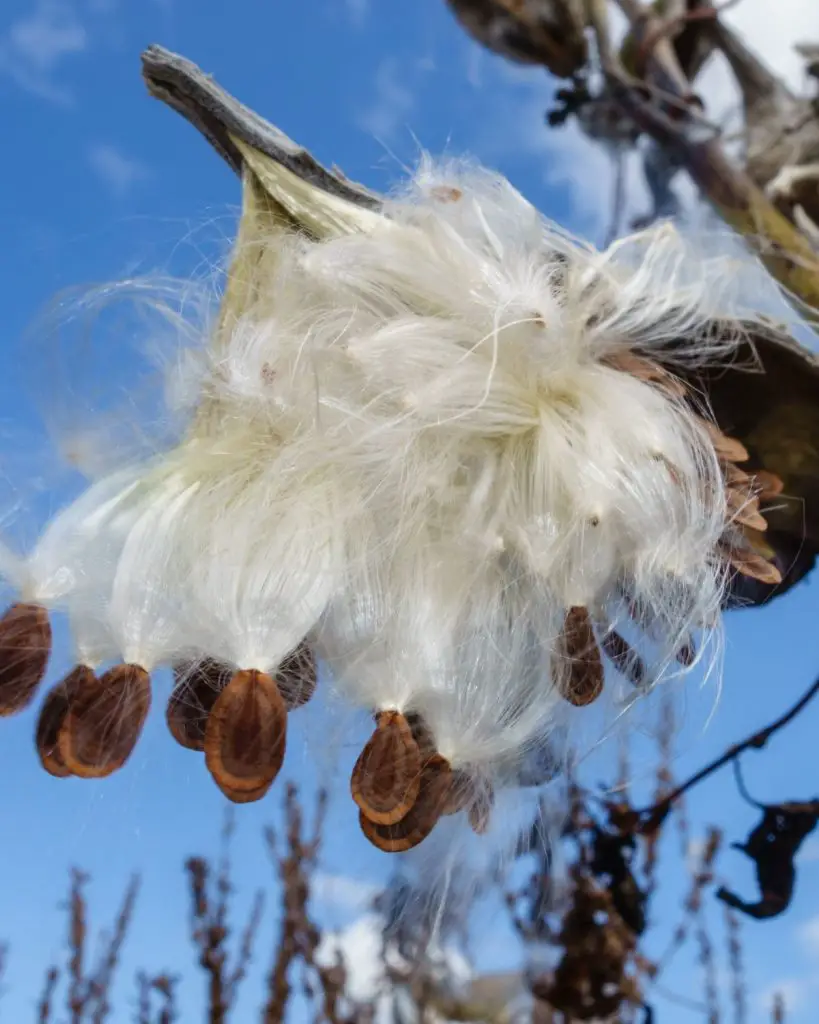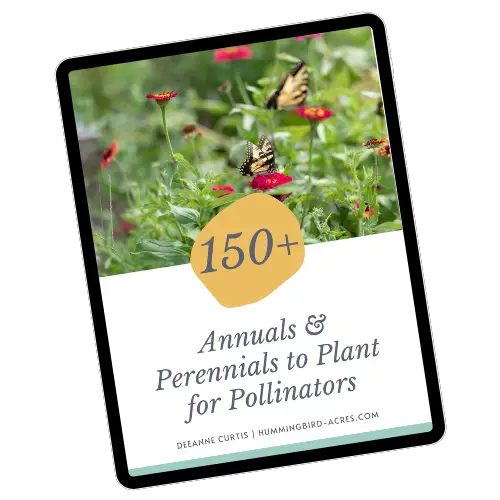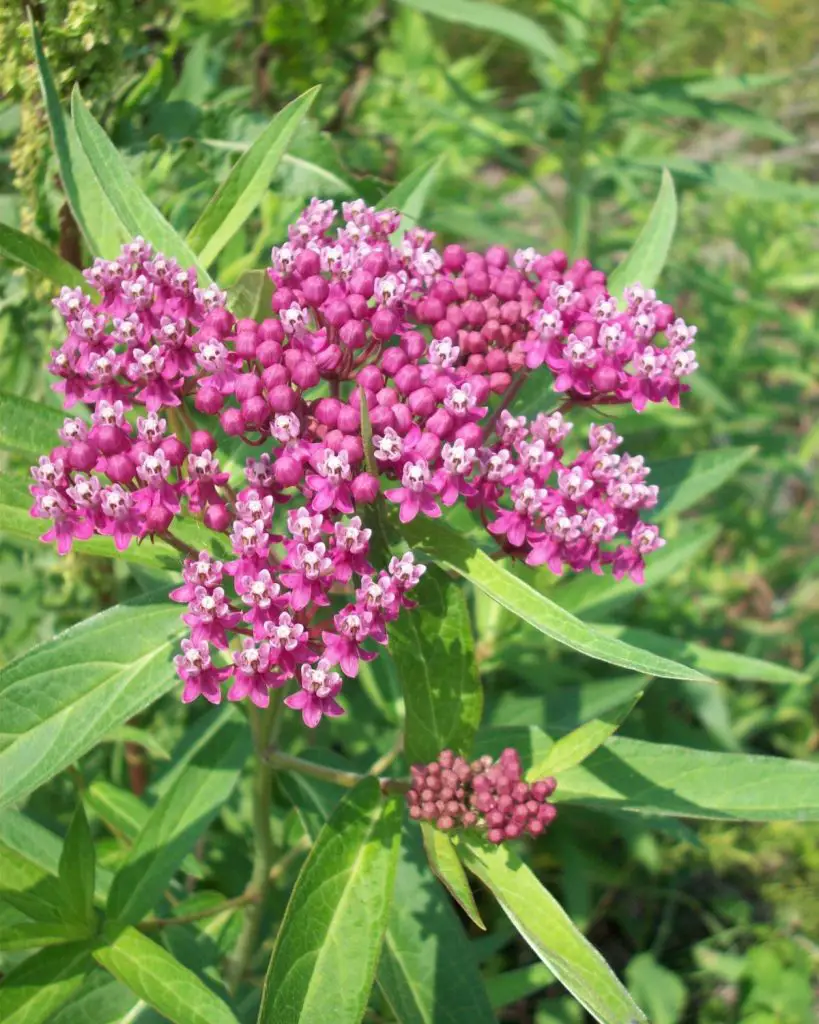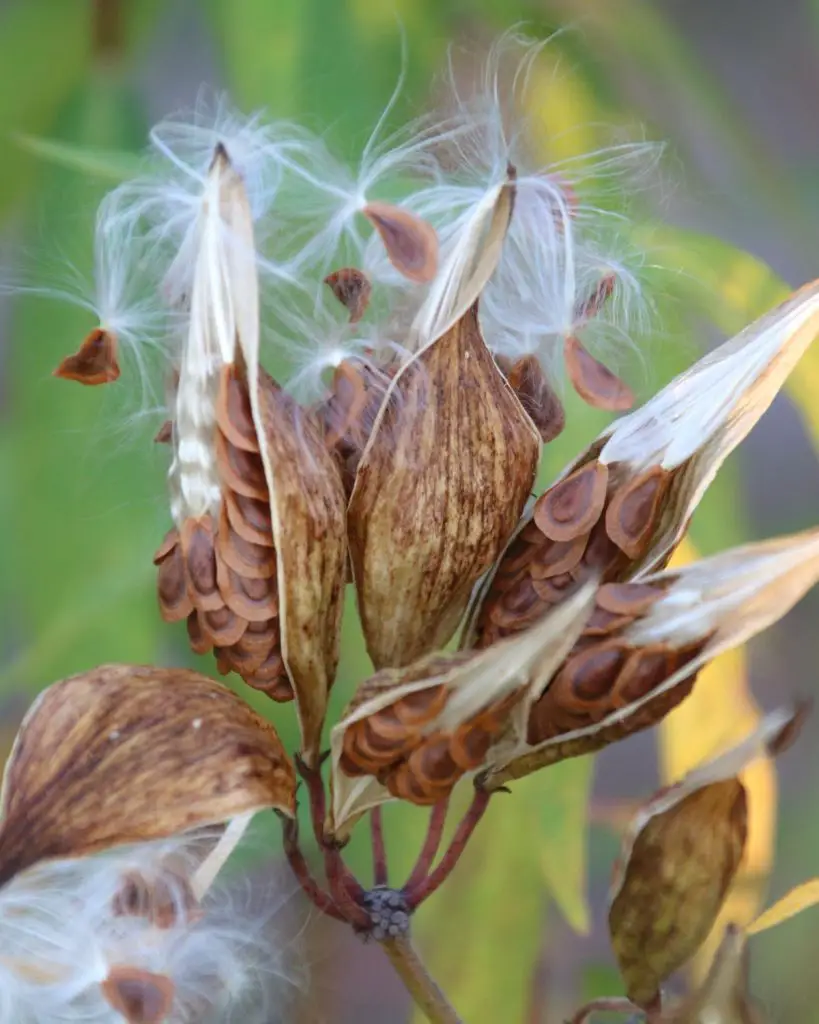Get Your Garden Growing: How to Collect Milkweed Seeds
Collecting milkweed seeds is a simple and rewarding way to support the conservation of nature and pollinators like monarch butterflies. Milkweed is the only plant that monarch caterpillars can eat, and the decline of milkweed populations has contributed to the decline of monarch populations. By collecting milkweed seeds, you can help to ensure that there is enough milkweed for monarchs to thrive.
To collect milkweed seeds, you will need to start by identifying mature milkweed pods. Timing is key when collecting milkweed seeds. You should wait until the pod is brown and has already popped open releasing their silky fluff, also called coma.
Once you have found a mature pod, you can begin to collect the seeds. It’s easier to collect milkweed seeds—and separate them from the silk—if you get to the pods right before they split open.
Disclosure: As an Amazon affiliate, I earn from qualifying purchases at no extra cost to you. My blog contains other affiliate links as well for your convenience. To learn more, you may read my Disclosure Policy. Thank you for supporting my blog!

Why Collect Milkweed Seeds?
If you are a nature lover, you may be interested in collecting milkweed seeds. Milkweed is a plant that is essential to the survival of monarch butterflies. Monarchs lay their eggs on milkweed, and their caterpillars feed exclusively on the plant. Therefore, collecting milkweed seeds can help to conserve the monarch butterfly population.
But milkweed is not just important for monarchs. It is also a crucial plant for other pollinators and wildlife. Milkweed flowers provide nectar for bees, butterflies, and other insects, while the plant’s leaves serve as a food source for many insects and animals. By collecting milkweed seeds, you can contribute to the conservation of these important species.
Collecting milkweed seeds also has benefits for your own garden. Milkweed is a beautiful plant that can add color and texture to any garden. It is also a hardy plant that can thrive in a variety of conditions. By collecting seeds, you can grow your own milkweed plants and create a habitat for pollinators and wildlife in your own backyard.
Overall, collecting milkweed seeds is a simple and rewarding way to contribute to the conservation of nature. By doing your part to preserve milkweed, you can help to ensure the survival of monarchs, pollinators, and other important species. So, grab your gardening gloves and get ready to collect some milkweed seeds!

When to Collect Milkweed Seeds
Harvesting milkweed seeds at the right time is crucial for successful germination and growth. Here are the best times to collect milkweed seeds:
Fall
In the fall, milkweed pods start to dry out and turn brown. This is a sign that the seeds are mature and ready to be collected. You can tell if the pods have split open on their own by the presence of silky fluff, also known as coma. If you see this, it’s a good indication that the seeds have already been released and may not be viable.
It’s best to collect the pods before they split open on their own. You can gently squeeze the pods to see if they are ready to harvest. If they are dry and crack easily, it’s time to collect the seeds. Be sure to wear gloves, as the sap from milkweed can be irritating to the skin.
Spring
In some regions, milkweed can be collected in the spring. If you live in an area with a late spring frost, it’s best to wait until after the last frost before collecting the seeds. The seeds need warm soil to germinate and grow, and a late frost can damage or kill the young plants.
When collecting milkweed seeds in the spring, look for fresh, green pods that are still intact. These pods are not yet mature, but they will be in a few weeks. Keep an eye on the pods and collect them as soon as they start to turn brown and dry out.
In general, it’s best to collect milkweed seeds in the fall when the pods are mature and the seeds have had time to fully develop. However, if you miss the fall window, collecting in the spring is a good alternative.
Remember to store your milkweed seeds in a cool, dry place until you’re ready to plant them. With the right timing and care, you can successfully grow milkweed and help support the monarch butterfly population.

Get our
Secret Guide to Butterfly Gardening
Everything you need to start and maintain a vibrant and colorful butterfly garden.
How to Harvest Milkweed Seeds
If you want to collect milkweed seeds, there are a few things you need to know. Here’s a step-by-step guide to help you harvest milkweed seeds successfully.
Removing Seeds
First, you need to find the right time to harvest the seeds. Wait until the milkweed pods are brown and dry, and the pods split open to reveal the ripe seeds. Once the pods are ready, you can start collecting the seeds.
To remove the seeds from the pods, gently pull them apart. You can also use a pair of scissors or a knife to cut the pods open. Be careful not to damage the seeds or the fluff.
Drying
After you’ve collected the seeds, you need to dry them. Spread them out on a tray or a piece of paper and let them dry for a few days. Make sure they’re not in direct sunlight or in a humid place. You can also use a dehydrator to speed up the process.
Separating Seeds from Fluff
Once the seeds are dry, you need to separate them from the fluff. There are a few ways to do this:
- Use a sieve or a strainer to separate the seeds from the fluff.
- Put the seeds and fluff in a paper bag and shake it. The fluff will come off, and the seeds will stay at the bottom.
- Use a vacuum cleaner to suck up the fluff, leaving the seeds behind.
Make sure you store the seeds in a cool, dry place. You can use an airtight container or a paper bag. Label the container with the date and the type of milkweed, so you know what you have.
That’s it! Harvesting milkweed seeds is easy, and it’s a great way to help the monarch butterflies. Now you can plant the seeds and watch the milkweed grow.

Storing Milkweed Seeds
After collecting the milkweed seeds, you will need to store them properly to ensure their viability. Here are some tips on how to store milkweed seeds.
Container Options
When storing milkweed seeds, it is important to use a container that is airtight. This will prevent moisture from getting inside and damaging the seeds. You can use plastic bags, envelopes, or sealed jars for storing the seeds. If you are using a plastic bag, make sure to remove as much air as possible before sealing it.
Seed Stratification
Milkweed seeds have a hard coating that needs to be broken down before they can germinate. This process is called stratification, and it involves exposing the seeds to cold temperatures for a period of time. To stratify your milkweed seeds, place them in a container with a moist medium such as sand or vermiculite. Then, put the container in the refrigerator for 4-6 weeks. After the stratification period is over, take the seeds out of the refrigerator and let them come to room temperature before planting.
Other Tips
Here are some additional tips for storing milkweed seeds:
- Make sure the seeds are completely dry before storing them. You can dry them on a screen for a few days before putting them in a container.
- Label the container with the date and type of milkweed seeds inside.
- Store the container in the refrigerator until you are ready to plant the seeds.
- Check on the seeds periodically to make sure they are still viable. If they start to mold or turn brown, they may no longer be viable and should be discarded.
By following these tips, you can store your milkweed seeds properly and increase your chances of success when it comes time to plant them.
Planting Milkweed Seeds
When it comes to planting milkweed seeds, there are a few things you should keep in mind. In this section, we’ll cover the basics of germinating seeds, starting seeds indoors, and direct-sowing in the garden.
Germinating Seeds
Before you can plant milkweed seeds, you need to make sure they’re viable. Germination rates can vary depending on the species of milkweed and the conditions they’re grown in. To test the viability of your seeds, you can perform a simple float test. Place your seeds in a bowl of water and wait for them to sink. If they float, they’re not viable and won’t germinate.
Once you have viable seeds, you can start the germination process. Milkweed seeds need to be stratified, which means they need to be exposed to cold temperatures for a period of time before they’ll germinate. You can stratify your seeds by placing them in a plastic bag with a damp paper towel and storing them in the refrigerator for 4-6 weeks.
Starting Seeds Indoors
If you want to get a head start on the growing season, you can start your milkweed seeds indoors. Fill a seed-starting tray with a potting mix and sow your seeds according to the instructions on the packet. Milkweed seeds need to be covered with a thin layer of soil and kept moist until they germinate.
Once your seedlings have emerged, you can move them to a sunny windowsill or under artificial lights. Make sure to keep the soil moist and provide your seedlings with plenty of light to help them grow.
Direct-Sow in the Garden
If you prefer to plant seeds directly in the garden, you can do so in the spring after the danger of frost has passed. Choose a sunny location with well-draining soil and prepare the soil by removing any weeds and loosening the top layer.
Sow your seeds according to the instructions on the packet and cover them with a thin layer of soil. Keep the soil moist until your seedlings emerge, and then water them regularly to help them grow.
By following these simple steps, you can successfully plant milkweed seeds and grow beautiful milkweed plants in your garden. Happy planting!
Learn More about Growing Milkweed – HERE!

Grab my free
150 Plants for Pollinators
Plant These to Attract Butterflies and Pollinators to Your Garden!
Enter your name & email so we can send you your FREE Guide.
[convertkit form=5600487]
Caring for Milkweed Plants
When it comes to caring for milkweed plants, there are a few things you should keep in mind to ensure that your plants grow healthy and strong. Here are some tips:
Transplanting Seedlings
If you’re transplanting milkweed seedlings, make sure to do it carefully to avoid damaging the roots. Use a trowel to dig a hole big enough to accommodate the root ball of the seedling. Carefully remove the seedling from its pot, being careful not to damage the roots. Place the seedling in the hole and fill in with soil. Water the plant thoroughly.
Growing Milkweed Plants
Different types of milkweed plants have different growing requirements. For example, tropical milkweed prefers warm, humid conditions, while swamp milkweed prefers moist soil. Common milkweed and honeyvine milkweed are more tolerant of different growing conditions.
When planting milkweed, make sure to choose a spot with plenty of sunlight and well-draining soil. Water the plants regularly, especially during hot, dry weather. Mulching around the base of the plants can help retain moisture in the soil.
Foraging and Pest Control
If you plan on foraging for milkweed pods or leaves, make sure to do it responsibly. Only take what you need and leave some for the wildlife that depend on the plant. Additionally, make sure to avoid areas where pesticides or herbicides have been used.
Milkweed plants can be prone to pests like aphids and milkweed bugs. To control these pests, you can try using natural methods like introducing beneficial insects or using insecticidal soap. However, be careful not to harm beneficial insects like monarch caterpillars.
Finally, be aware of the potential risks of using pesticides around milkweed plants. Pesticides can harm not only pests but also beneficial insects and other wildlife. If you must use pesticides, choose products that are safe for use around milkweed plants and follow the instructions carefully.
By following these tips, you can help ensure that your milkweed plants grow healthy and strong, providing important habitat for monarch butterflies and other wildlife.

Sharing Milkweed Seeds
If you have collected more milkweed seeds than you need, consider sharing them with others. Here are a few ways you can share your milkweed seeds:
Seed Swap
Seed swaps are a great way to share seeds and connect with other gardeners. Look for local seed swaps in your area, or organize your own. You can bring your extra milkweed seeds to the swap and trade them for other seeds that you are interested in growing.
Donating Seeds to Friends and Family
If you have friends or family members who are interested in gardening, consider giving them some of your extra milkweed seeds. This is a great way to share your love of gardening and help support monarch populations.
Conservation Efforts
There are many conservation organizations that work to protect monarch populations and their habitats. Consider donating some of your milkweed seeds to these organizations to help support their efforts. Some organizations, like the Live Monarch Foundation, even have programs where you can donate milkweed seeds to be distributed to people who are raising monarch caterpillars.
Remember to save some seeds for yourself, too. Milkweed seeds can be stored for several months in a cool, dry place. Label your seeds with the date collected and the genus of the milkweed plant, so you can keep track of what you have.
By sharing your milkweed seeds, you can help support monarch populations and spread awareness about the importance of milkweed in their life cycle.

You may also enjoy these related articles:
Did you enjoy this article? Want to hear more? Stay in touch! Sign up below to receive weekly tips and inspiration for your homestead.
